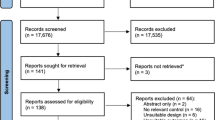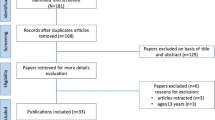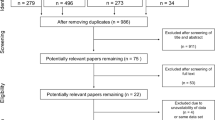Abstract
Background
Economy, velocity/power at maximal oxygen uptake (\( {\text {v}} \dot{V}{\text{O}}_{2 \, \hbox{max} } /{\text w}\dot{V}{\text{O}}_{2 \, \hbox{max} } \)) and endurance-specific muscle power tests (i.e. maximal anaerobic running velocity; vMART), are now thought to be the best performance predictors in elite endurance athletes. In addition to cardiovascular function, these key performance indicators are believed to be partly dictated by the neuromuscular system. One technique to improve neuromuscular efficiency in athletes is through strength training.
Objective
The aim of this systematic review was to search the body of scientific literature for original research investigating the effect of strength training on performance indicators in well-trained endurance athletes—specifically economy, \( {\text{v}}\dot{V}{\text{O}}_{2 \, \hbox{max} } /\,{\text{w}}\dot{V}{\text{O}}_{2 \, \hbox{max} } \) and muscle power (vMART).
Methods
A search was performed using the MEDLINE, PubMed, ScienceDirect, SPORTDiscus and Web of Science search engines. Twenty-six studies met the inclusion criteria (athletes had to be trained endurance athletes with ≥6 months endurance training, training ≥6 h per week OR \( \dot{V}{\text{O}}_{2 \, \hbox{max} } \) ≥50 mL/min/kg, the strength interventions had to be ≥5 weeks in duration, and control groups used). All studies were reviewed using the PEDro scale.
Results
The results showed that strength training improved time-trial performance, economy, \( {\text{v}}\dot{V}{\text{O}}_{2 \, \hbox{max} } /{\text{w}}\dot{V}{\text{O}}_{2 \, \hbox{max} } \) and vMART in competitive endurance athletes.
Conclusion
The present research available supports the addition of strength training in an endurance athlete’s programme for improved economy, \( {\text{v}}\dot{V}{\text{O}}_{2 \, \hbox{max} } /{\text{w}}\dot{V}{\text{O}}_{2 \, \hbox{max} } \), muscle power and performance. However, it is evident that further research is needed. Future investigations should include valid strength assessments (i.e. squats, jump squats, drop jumps) through a range of velocities (maximal-strength ↔ strength-speed ↔ speed-strength ↔ reactive-strength), and administer appropriate strength programmes (exercise, load and velocity prescription) over a long-term intervention period (>6 months) for optimal transfer to performance.


Similar content being viewed by others
References
Bassett DR, Howley ET. Limiting factors for maximum oxygen uptake and determinants of endurance performance. Med Sci Sports Exerc. 2000;32(1):70–84.
Paavolainen L, Nummela A, Rusko H. Muscle power factors and VO2max as determinants of horizontal and uphill running performance. Scand J Med Sci Sports. 2000;10:286–91.
Foster C, Lucia A. Running economy: the forgotten factor in elite performance. Sports Med. 2007;37(4–5):316–9.
Fletcher JR, Esau SP, MacIntosh BR. Economy of running: beyond the measurement of oxygen uptake. J Appl Physiol. 2009;107:1918–22.
Paavolainen L, Hakkinen K, Hamalainen I, et al. Explosive strength training improves 5-km running time by improving running economy and muscle power. J Appl Physiol. 1999;86:1527–33.
Nummela A, Alberts M, Rijntjes RP, et al. Reliability and validity of the maximal anaerobic running test. Int J Sports Med. 1996;17(2 Suppl):97–102.
McLaughlin JE, Howley ET, Bassett DR, et al. Test of the classic model for predicting endurance running performance. Med Sci Sports Exerc. 2010;42(5):991–7.
Millet GP, Dréano P, Bentley DJ. Physiological characteristics of elite short- and long-distance triathletes. Eur J Appl Physiol. 2003;88:427–30.
Zatsiorsky VM. Science and practice of strength training. Champaign: Human Kinetics; 1995.
Karp JR. Training characteristics of qualifiers for the U.S. Olympic Marathon Trials. Int J Sports Physiol Perform. 2007;2:72–92.
Maher CG, Sherrington C, Herbert RD, et al. Reliability of the PEDro scale for rating quality of randomized controlled trials. Phys Ther. 2003;83(8):713–21.
Johnston RE, Quinn TJ, Kertzer R, et al. Strength training in female distance runners: impact on running economy. J Strength Cond Res. 1997;11(4):224–9.
Spurrs RW, Murphy AJ, Watsford ML. The effect of plyometric training on distance running performance. Eur J Appl Physiol. 2003;89:1–7.
Saunders PU, Telford RD, Pyne DB, et al. Short-term plyometric training improves running economy in highly trained middle and long distance runners. J Strength Cond Res. 2006;20(4):947–54.
Berryman N, Maurel D, Bosquet L. Effect of plyometric vs. dynamic weight training on the energy cost of running. J Strength Cond Res. 2010;24(7):1818–25.
Fletcher JR, Esau SP, MacIntosh BR. Changes in tendon stiffness and running economy in highly trained distance runners. Eur J Appl Physiol. 2010;110:1037–46.
Jackson NP, Matthew SH, Reiser RF. High resistance/low repetition vs. low resistance/high repetition training: effects on performance of trained cyclists. J Strength Cond Res. 2007;21(1):289–95.
Levin GT, McGuigan MR, Laursen PB. Effect of concurrent resistance and endurance training on physiologic and performance parameters of well-trained endurance cyclists. J Strength Cond Res. 2009;23(8):2280–6.
Aagaard P, Andersen JL, Bennekou M, et al. Effects of resistance training on endurance capacity and muscle fiber composition in young cyclists. Scand J Med Sci Sports. 2011;21:298–307.
Hoff J, Helgerud J, Wisløff U. Maximal strength training improves work economy in trained female cross-country skiers. Med Sci Sports Exerc. 1999;31(6):870–7.
Hoff J, Gran A, Helgerud J. Maximal strength training improves aerobic performance. Scand J Med Sci Sports. 2002;12:288–95.
Østerås H, Helgerud J, Hoff J. Maximal strength-training effects on force–velocity and force–power relationships explain increases in aerobic performance in humans. Eur J Appl Physiol. 2002;88:255–63.
Millet GP, Jaouen B, Borrani F, et al. Effects of concurrent endurance and strength training on running economy and VO2 kinetics. Med Sci Sports Exerc. 2002;34(8):1351–9.
Hausswirth C, Argentin S, Bieuzen Y, et al. Endurance and strength training effects on physiological and muscular parameters during prolonged cycling. J Electromyogr Kinesiol. 2009;20:330–9.
Bonacci J, Green D, Saunders PU, et al. Plyometric training as an intervention to correct altered neuromotor control during running after cycling in triathletes: a preliminary randomized controlled trial. Phys Ther Sport. 2011;12:15–21.
Mikkola JS, Rusko HK, Nummela AT, et al. Concurrent endurance and explosive type strength training increases activation and fast force production of leg extensor muscles in endurance athletes. J Strength Cond Res. 2007;21(2):613–20.
Mikkola J, Rusko H, Nummela A, et al. Concurrent endurance and explosive type strength training improves neuromuscular and anaerobic characteristics in young distance runners. Int J Sports Med. 2007;28(7):602–11.
Rønnestad BR, Hansen EA, Raastad T. In-season strength maintenance training increases well-trained cyclists’ performance. Eur J Appl Physiol. 2010;110(6):1269–82.
Rønnestad BR, Hansen EA, Raastad T. Strength training affects tendon cross-sectional area and freely chosen cadence differently in non-cyclists and well-trained cyclists. J Strength Cond Res. 2012;26(1):158–66.
Rønnestad BR, Hansen EA, Raastad T. Strength training improves 5-min all out performance following 185 min of cycling. Scand J Med Sci Sports. 2011;21(2):250–9.
Rønnestad BR, Hansen EA, Raastad T. Effect of heavy strength training on thigh muscle cross-sectional area, performance determinants, and performance in well-trained cyclists. Eur J Appl Physiol. 2010;108:965–75.
Rønnestad BR, Kojedal Ø, Losnegard T, et al. Effect of heavy strength training on muscle thickness, strength, jump performance, and endurance performance in well-trained Nordic Combined athletes. Eur J Appl Physiol. 2012;112:2241–352.
Losnegard T, Mikkelson K, Rønnestad BR, et al. The effect of heavy strength training on muscle mass and physical performance in elite cross country skiers. Scand J Med Sci Sports. 2011;21:389–401.
Sunde A, Støren Ø, Bjerkaas M, et al. Maximal strength training improves cycling economy in competitive cyclists. J Strength Cond Res. 2010;24(8):2157–65.
Bastiaans JJ, Van Diemen AB, Veneberg T, et al. The effects of replacing a portion of endurance training by explosive strength training on performance in trained cyclists. Eur J Appl Physiol. 2001;86:79–84.
Støren O, Helgerud J, Støa EM, et al. Maximal strength training improves running economy in distance runners. Med Sci Sports Exerc. 2008;40:1089–94.
Newton RU, Cormie P, Cardinale M. Principles of athletic testing. In: Cardinale M, Newton R, Nosaka K, editors. Strength and conditioning: biological principles and practical application. Oxford: Wiley-Blackwell; 2011. p. 255–70.
Siff M. Supertraining. 2nd ed. Denver (CO): Supertraining Institute; 2003. p. 20.
Brughelli M, Cronin J. Influence of running velocity on vertical, leg and joint stiffness: modelling and recommendations for future research. Sports Med. 2008;38(8):647–67.
Schmidtbleicher D. Training for power events. In: Komi PV, editor. The encyclopedia of sports medicine. Vol. 3: strength and power in sport. Oxford: Blackwell; 1992. p. 169–79.
Flanagan EP, Comyns TM. The use of contact time and the reactive strength index to optimize fast stretch-shortening cycle training. Strength Cond J. 2008;30(5):32–8.
Jeukendrup AE, Craig NP, Hawley JA. The bioenergetics of world class cycling. J Sci Med Sports. 2000;3(4):414–33.
Saunders PU, Pyne DB, Telford RD, et al. Factors affecting running economy in trained distance runners. Sports Med. 2004;34(7):465–85.
Noakes TD. Lore of running. 4th ed. Champaign: Human kinetics; 2003. p. 19–21.
Berg K. Endurance training and performance in runners: research limitations and unanswered questions. Sports Med. 2003;33(1):59–73.
Paavolainen LM, Nummela AT, Rusko HK. Neuromuscular characteristics and muscle power as determinants of 5 km running performance. Med Sci Sports Exerc. 1999;31:124–30.
Noakes TD. Implications of exercise testing for prediction of athletic performance: a contemporary perspective. Med Sci Sports Exerc. 1988;20:319–30.
Kraemer WJ, Ratamess NA. Fundamentals of resistance training: progression and exercise prescription. Med Sci Sports Exerc. 2004;36(4):674–88.
Appleby B, Newton RU, Cormie P. Changes in strength over a 2-year period in professional rugby union players. J Strength Cond Res. 2012;26(9):2538–46.
Stone MH, Stone ME. Resistance training modes: a practical perspective. In: Cardinale M, Newton R, Nosaka K, editors. Strength and conditioning: biological principles and practical application. Oxford: Wiley-Blackwell; 2011. p. 353.
Cormie P, McGuigan MR, Newton RU. Developing maximal neuromuscular power. Part 2: training considerations for improving maximal power production. Sports Med. 2011;41(2):125–46.
Stensdotter AK, Hodges PW, Mellor R, et al. Quadriceps activation in closed and in open kinetic chain exercise. Med Sci Sports Exerc. 2003;35(12):2043–7.
Cormie R, McGuigan MR, Newton RU. Adaptations in athletic performance after ballistic power versus strength training. Med Sci Sports Exerc. 2010;42(8):1582–98.
Kaneko M, Fuchimoto T, Toji H, et al. Training effect of different loads on the force–velocity relationship and mechanical power output in human muscle. Scand J Med Sci Sports. 1983;5(2):50–5.
Dymond C, Flanagan EP, Turner AP. The relationship between maximal strength and plyometric ability in rugby players. Rev Port Cein Desp. 2011;11 Suppl. 2:77–80.
Hawley J. Molecular responses to strength and endurance training: are they incompatible? Appl Physiol Nutr Metab. 2009;34:355–61.
Acknowledgments
The authors have no potential conflicts of interest that are directly relevant to the content of this review. This research is supported by funding from the University of Limerick Physical Education and Sport Science (PESS) Scholarship 2012.
Author information
Authors and Affiliations
Corresponding author
Rights and permissions
About this article
Cite this article
Beattie, K., Kenny, I.C., Lyons, M. et al. The Effect of Strength Training on Performance in Endurance Athletes. Sports Med 44, 845–865 (2014). https://doi.org/10.1007/s40279-014-0157-y
Published:
Issue Date:
DOI: https://doi.org/10.1007/s40279-014-0157-y




